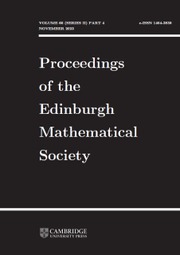No CrossRef data available.
Article contents
Remarks on module-finite pairs
Published online by Cambridge University Press: 20 January 2009
Extract
Core share and HTML view are not available for this content. However, as you have access to this content, a full PDF is available via the ‘Save PDF’ action button.
Let R ⊊ T be an extension of commutative rings having the same identity. A. Wadsworth (10) studies the situation when R and T are integral domains, and all rings between R and T are Noetherian. In this case (R, T) is called a Noetherian pair. In a similar vein, E. Davis (4) studies normal pairs and I. Papick (8) shows when coherent pairs are Noetherian pairs.
- Type
- Research Article
- Information
- Copyright
- Copyright © Edinburgh Mathematical Society 1981
References
REFERENCES
(1)Attyah, M. and MacDonald, I., Introduction to Commutative Algebra (Addison-Wesley, Reading, Mass., 1969).Google Scholar
(4)Davis, E., Overrings of commutative rings III; Normal pairs, Trans. Amer. Math. Soc. 182 (1973), 175–185.Google Scholar
(5)Dobbs, D. and Papick, I., When is D + M coherent?, Proc. Amer. Math. Soc. 56 (1976), 51–54.Google Scholar
(6)Harris, M., Some results on coherent rings, Proc. Amer. Math. Soc. 17 (1966), 474–479.Google Scholar
(8)Papick, I., When coherent pairs are Noetherian pairs, Houston J. Math. 5 (1979), 559–564.Google Scholar
(9)Vasconcelos, W., Annihilators of modules with a finite free resolution, Proc. Amer. Math. Soc. 29 (1971), 440–442.Google Scholar
(10)Wadsworth, A., Pairs of domains where all intermediate domains are Noetherian, Trans. Amer. Math. Soc. 195 (1974), 201–211.Google Scholar


